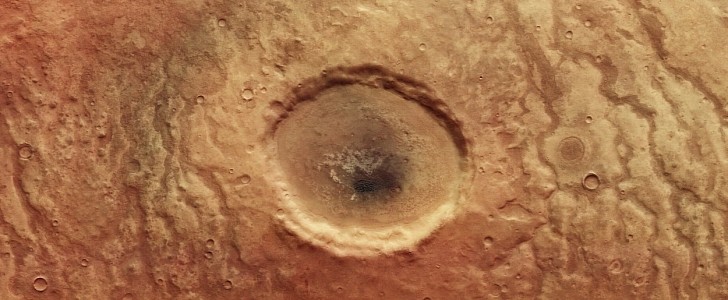Since it began orbiting our cold neighbor in 2003, ESA's Mars Express has been busy studying the planet's geology and its climate. Over the years, the spacecraft has sent back countless breathtaking views of the Red Planet's surface, including one that shows a massive crater that resembles a giant human eyeball.
Recently, the Mars Express took a closer look at an upland region in the southern highlands of the Red Planet called Aonia Terra. The spacecraft spotted a crater that stretches for approximately 30 km (18.6 miles) across a landscape that features twisting channels. Billions of years ago, these channels that look like blood vessels running through a human eyeball might have carried fluids across the surface of Mars.
The European Space Agency (ESA) says that the channels look darker in some areas and seem to be raised above the ground. It's possible that erosion-resistant sediment collected at the bottom when water passed through them, explaining their appearance. On the other hand, maybe they weren't even filled with water and were carrying molten lava.
The terrain surrounding the "eyeball" in the recent images obtained by the spacecraft has a variety of colors, implying that Aonia Terra is made up of more than one element. Inside the crater, you can notice that there's a dark area that looks like a pupil, which is surrounded by lighter material.
The crater also features dunes and cone-shaped hills, suggesting that not only the surrounding region contains different elements but also that they have accumulated inside the crater as well. But the image also shows surfaces that don’t have as many formations. To the north of the crater is a smoother area that appears to be lighter.
Mars will always continue to surprise scientists with its diverse landscape. Sometimes, we even get to see formations like these with unusual shapes that make it look like an active place rather than a dead and dusty planet.
The European Space Agency (ESA) says that the channels look darker in some areas and seem to be raised above the ground. It's possible that erosion-resistant sediment collected at the bottom when water passed through them, explaining their appearance. On the other hand, maybe they weren't even filled with water and were carrying molten lava.
The terrain surrounding the "eyeball" in the recent images obtained by the spacecraft has a variety of colors, implying that Aonia Terra is made up of more than one element. Inside the crater, you can notice that there's a dark area that looks like a pupil, which is surrounded by lighter material.
The crater also features dunes and cone-shaped hills, suggesting that not only the surrounding region contains different elements but also that they have accumulated inside the crater as well. But the image also shows surfaces that don’t have as many formations. To the north of the crater is a smoother area that appears to be lighter.
Mars will always continue to surprise scientists with its diverse landscape. Sometimes, we even get to see formations like these with unusual shapes that make it look like an active place rather than a dead and dusty planet.



